Often called the “king of exercises,” squat exercises are a must-try if you’re looking to supercharge your workout routine and build lower body strength.
This compound movement engages your lower body, core, and back muscles, targeting multiple muscle groups. You develop your glutes, quads, hamstrings, and calves, enhance mobility, and promote functional movement with squats.
Benefits of Squat Exercises
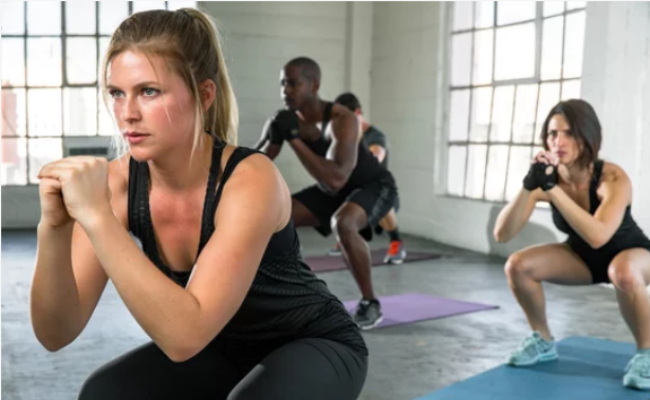 In this article, we’ll explore the numerous advantages of incorporating squats into your exercise regimen. You’ll also learn the significance of proper technique and squat variations to help you maximize your results.
In this article, we’ll explore the numerous advantages of incorporating squats into your exercise regimen. You’ll also learn the significance of proper technique and squat variations to help you maximize your results.
Squat exercises offer many benefits for those looking to improve their fitness levels. They are among the most effective ways to build strength in the lower body. They can also improve posture by strengthening the back, shoulders, and hip muscles.
Squats can help prevent back pain and improve spinal alignment. They also help make your hips, ankles, and knees more flexible. Flexibility in these joints can improve your range of motion and help prevent injuries.
You may also like: Get Fit in Style: The Best Workout Sets for Women
Enhancing Core Stability
Squats play a significant role in improving core stability. They engage the core muscles throughout the entire exercise, from the initial descent to the return to standing.
This engagement of the core muscles improves core stability and helps prevent injury. According to research, squats generate high levels of core muscle activation compared to other lower-body exercises.
Burning Calories and Fat
Exercises that engage large muscle groups stimulate a higher metabolic response than those that target smaller ones. This means squats can increase metabolic rate, leading to greater calorie and fat burning.
Personal trainer and fitness expert Tony Gentilcore explained that squat exercises are among the most effective for burning calories. He says they are a “big bang for your buck.”
Techniques for Proper Squat Form
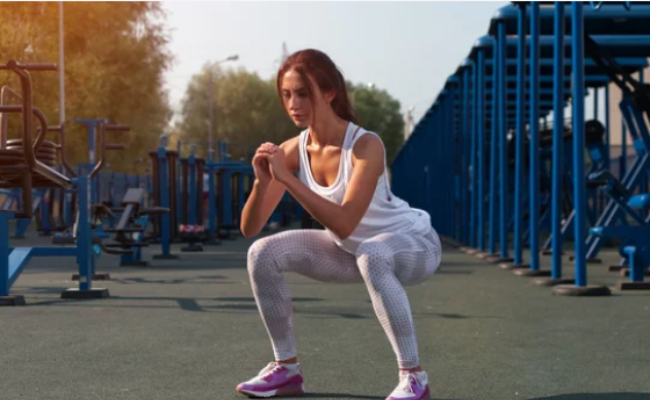
Photo credit: Adobe Stock
Proper squat exercise technique is crucial for maximizing benefits and preventing injury. Follow these step-by-step instructions to perform squats properly:
- Place your feet shoulder-width apart, toes pointing slightly outward.
- Stand with your feet parallel to each other.
- As you squat, keep your knees over your toes and do not collapse inward.
- Keep your weight distributed across your feet, and do not shift onto your toes or heels.
- Begin the squat by hinging your hips backward and down as if you were sitting back in a tiny chair.
- Keep your chest and your back straight throughout the movement.
- Descend into the squat until your thighs are parallel to the ground or just a bit lower.
- Make sure your knees do not extend past your toes.
- Push with your heels and drive your hips forward to return to standing.
Common mistakes to avoid when performing squats include:
- Rounding your back or hunching over
- Shifting your weight onto your heels or toes
- Rising with your butt first
- Not keeping your back straight
- Moving too forward when you bend your knees
- Not squatting deep enough
- Angling your knees inward
Importance of Breathing Techniques
Proper breathing during squats ensures constant oxygen flow to the working muscles and enhances performance. As you descend into the squat, take a deep breath and hold it.
Exhale forcefully as you push through the heels and move your hips forward to return to a standing position. This technique stabilizes the core allowing you to lift heavier weights with greater stability and control.
Squat Variations for a Total-Body Workout
There are several squat variations that you can include in your fitness routine. Here are some examples from beginner to more advanced levels:
Front Squats
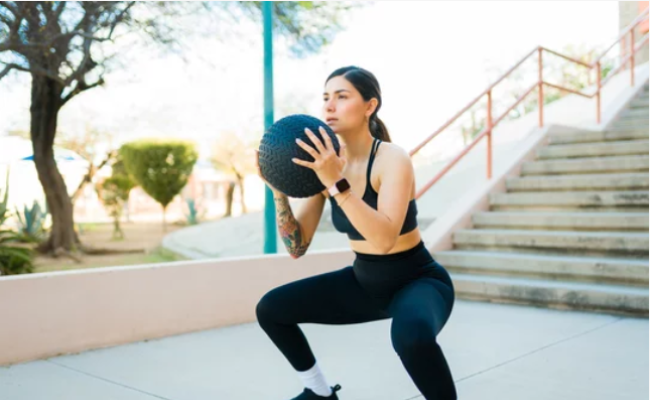
Photo credit: Adobe Stock
Front squats emphasize the quadriceps and core muscles more. Place a barbell across your shoulders to perform a front squat with your palms facing up and elbows pointing forward. Lower your torso into a squat, and keep your chest and back straight.
Sumo Squats
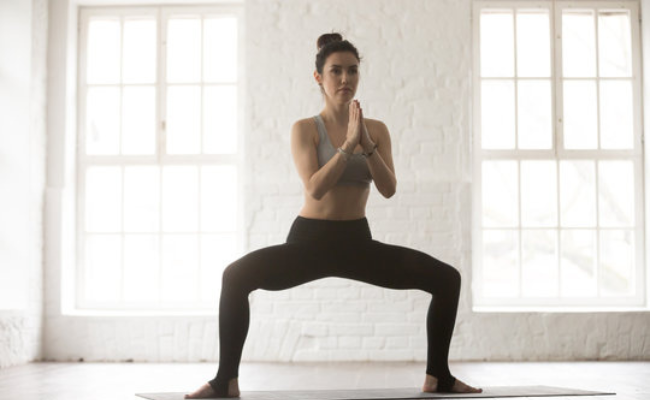
Photo credit: Adobe Stock
Sumo squats target the inner thigh muscles and glutes. To perform a sumo squat, position your feet hip width apart and turn your toes outward. Descend into a squat while keeping your knees aligned with your toes and your chest up.
Goblet Squats
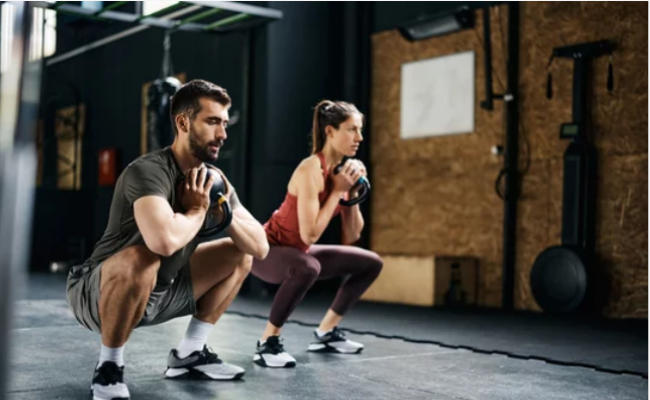
Photo credit: Adobe Stock
Goblet squats are an excellent option for beginners. They are less complex and easier to perform than other squat variations. Goblet squats target the quads, glutes, and core muscles.
Grab a kettlebell or dumbbell and position it at your chest level with your elbows facing downwards. Descend into a squat while keeping your chest lifted and back upright.
Advanced Squat Variations
Pistol squats
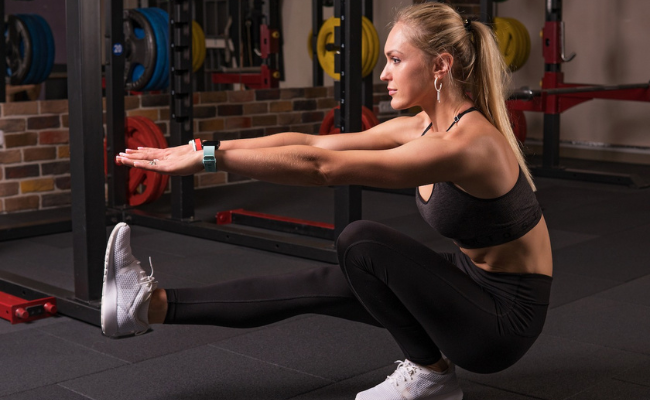
Photo credit: Adobe Stock
Pistol squats target the quads, glutes, and core muscles. It also engages the stabilizer muscles in the ankle and left foot. To do a pistol squat, balance on a single leg while extending the other leg in front of you. Descend into a squat with an upright chest and straight back, and reach your arms out in front to maintain stability.
Overhead Squats
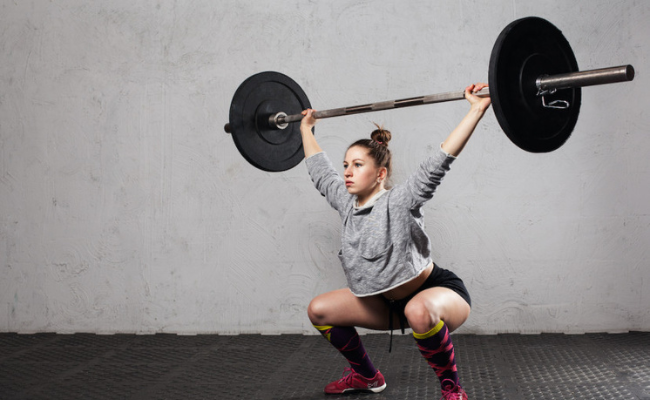
Photo credit: Adobe Stock
These full-body exercises target the quads, glutes, core, and upper back muscles. Hold a barbell or dumbbell overhead with your arms fully extended to perform an overhead squat. Lower yourself into a squat, keeping your arms overhead and your chest up.
Here are other advanced squat positions:
- Barbell back squats
- Loaded squats
- Skater squat
- Jump squat
- Bulgarian split squat
Incorporating Squat Exercises into Your Fitness Routine
Combining different squat variations into your fitness routine can target specific muscle groups and add variety to your workout. Aim to perform squat exercises at least twice weekly, including rest days in between, to allow muscle recovery.
As you progress in strength and endurance, you can increase the frequency to four or more times per week. Start with bodyweight squats and gradually increase the difficulty by adding weights, increasing reps, or using advanced variations.
Squats alone can provide a full-body workout, but including extra exercises can enhance the benefits and prevent muscle imbalances. Exercises targeting the glutes, deadlifts, and calf raises can complement squats and target different muscle groups.
Adequate rest and recovery are crucial for building muscle and preventing injury. Make sure to allow rest days between squat workouts and combine proper nutrition and hydration with supporting muscle recovery.
You may also like: Hamstring Workouts to Improve Athletic Performance
Creating a Balanced Workout Routine
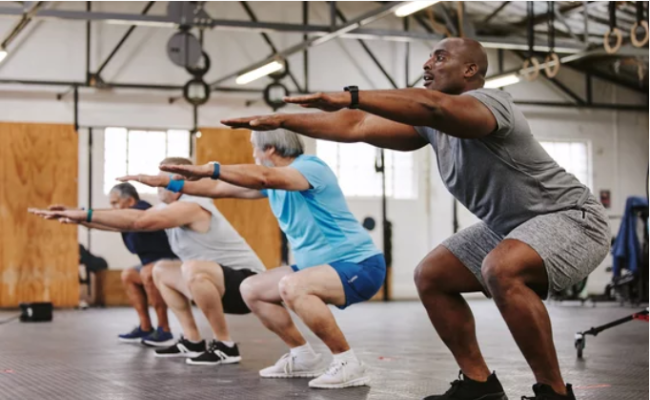
Photo credit: Adobe Stock
Squats are ideal for developing lower body strength and fitness. However, balancing them with other exercises is vital for a well-rounded routine.
Focusing exclusively on squats can lead to muscle imbalances and increase the risk of injury. Ensure you also target your upper body and core to help you add stability to your squats and other lifts.
Conclusion
Squats are a highly effective and versatile addition to any fitness routine. They provide numerous benefits, including improved strength, posture, core stability, flexibility, and fat burning.
Remember to balance squat exercises with complementary exercises for a well-rounded fitness routine. There are many variations available to suit different fitness routine levels and goals.
Correct form and technique are also essential for safety and injury prevention. Squat workouts can assist you in achieving your fitness goals while improving your health and well-being.
Common Questions and Concerns about Squat Exercises
Can squats be done without weights or equipment?
Yes, bodyweight squats are great for those who don’t have access to weights or equipment. They can still provide a challenging workout and offer similar benefits to weighted squats.
How often should squats be performed?
The frequency of squat exercises can vary depending on your fitness level and goals. Generally, you should perform squats two to three times per week, including rest days in between, to allow for muscle recovery.
What modifications can be made to squats to prevent injury?
You can use a squat rack or adjust your foot position or squat depth. You can also use resistance bands or weights to reduce the load on your body. These can help to make performing squats safer and more accessible.
What are common mistakes to avoid when performing squats?
It is vital to start with a proper form and technique. Then, gradually increase the weight or difficulty, and incorporate warm-up and cool-down exercises to prevent injury. Avoid these common mistakes when performing squat exercises:
- Improper form and technique
- Lifting too much weight too quickly
- Neglecting warm-up and cool-down exercises
Consult a qualified personal trainer or physical therapist for more information and expert advice on squat exercises and injury prevention. Online resources like fitness blogs or YouTube videos can also provide helpful tips and demonstrations.

